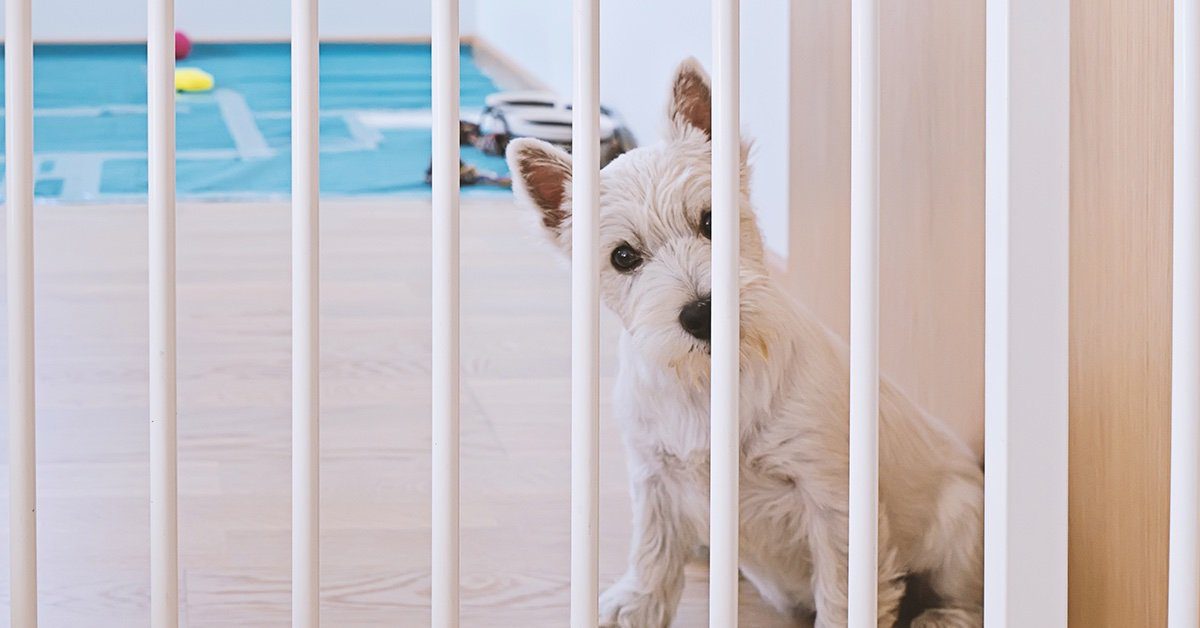While you want to spend every waking moment staring into your sweet puppy’s eyes, a full-time job, driving the kids to school, or other responsibilities might cut your time together short. Leaving you to wonder, “How long can I leave my puppy alone?”
The answer depends on how old your puppy is and how well-trained they are. As we know, puppies need bathroom breaks often, so it’s good to keep this in mind to prevent accidents and distress. According to the AKC, a good rule of thumb is to use your puppy’s age as a guide. Experts say you can usually leave your puppy alone for an hour for each month they’ve been alive after three months of age. For example, at five months of age, your puppy will probably be just fine for five hours. Before this phase of life, however, your puppy will likely need to go out every one to two hours – so you should be as present as possible. Your presence is also important for bonding and socialization during this critical period of their life.
While it may feel nerve-wracking to leave your pup alone for an extended period of time, if you know how to prepare them, they’ll slowly adapt. Whether it’s crate training or offering an irresistible chew toy, there are various ways to help your puppy acclimate to being alone.
Here are just a few things to keep in mind when leaving your puppy alone.
Puppy-proofing and preparing your house
When you leave your puppy home alone, the idea of them having zero supervision may worry you. One of the best ways to avoid unexpected accidents is to take preventative measures such as puppy-proofing your house.
Puppies are naturally inclined to be curious, especially if they’re in a new setting. They may explore and express their curiosity by chewing furniture or items that are not meant for dogs. Be wary of exposed electrical cords, human food, or chemical cleaning supplies that could potentially harm animals. Hide small household items that might be mistaken for toys, and provide your dog with plenty of other types of chew toys or puzzle toys instead. You can also use a puppy pen or a baby gate to set boundaries within an area that’s safe for your dog to explore.
Crate training for when you leave your puppy alone
Crate training provides a variety of benefits for your dog during their adjustment period. It’s a safe, structured routine for your puppy when they need a place to rest. It can also be used alongside a safe dog training collar for potty training to help minimize potty accidents in the house.
When introducing crate training to your puppy, it’s important to do so in a calm, encouraging manner. They need to view the crate as a sanctuary and develop a healthy habit of using it on a daily basis. Find ways to help your pup associate positive factors with the crate itself, whether it’s with their favorite chew toys, snacks, or cozy dog beds. Slowly but surely, they’ll find that they can relax in it, and that when you leave them alone, they’re still kept safe.
Depending on their month of age, dogs can stay in their crates for different periods of time. Younger dogs can only go from one to three hours, while older dogs can go for a few more. However, this shouldn’t be a daily practice, as your dog needs frequent movement and exercise to stay healthy.
Pet Pro Tip: New kitten owners often underestimate the long-term costs of veterinary care for a pet’s unexpected accidents & illnesses. Make sure you get your kitten insured as soon as possible!
Hiring a dog walker or pet sitter
If you and your family members are often out for work or school, consider hiring a dog walker or pet sitter to tend to your dog’s needs. With a regular pet sitter, you can trust that they get the interaction and supervision that they need, as well as more frequent potty breaks. With dog walkers, your pet will also have the opportunity to empty their bladder and minimize potty accidents in the house.
Doggy daycare is also a great alternative, as your companion will have the opportunity to socialize with other dogs and people. While they enjoy having playtime with their puppy friends, you can rest assured during your workday that they won’t have to wait for hours on end until you get home.
Providing plenty of play and interaction
Dogs are highly social animals that require daily stimulation from their pet parents. Make sure to interact with them just as much as you go out to make sure you build up your bond. Especially when they first join your family as a puppy, they need lots of attention, love, and patience to grow into sociable, healthy adult dogs.
You can gradually train your young dog to do well with alone time, but leaving them home alone for too long and too often can have a negative impact on their long-term development. In the long run, it’s crucial that you consider these options and implement necessary changes as early as possible. That way, you can guarantee that your puppy lives an exciting, healthy, and fulfilling life as they develop a meaningful connection with your family.
Unexpected accidents and injuries happen, especially for young puppies acclimating to new homes. Pumpkin’s dog insurance plans can help you pay for covered vet bills when the unexpected happens, ensuring they get the best care pawsible.




